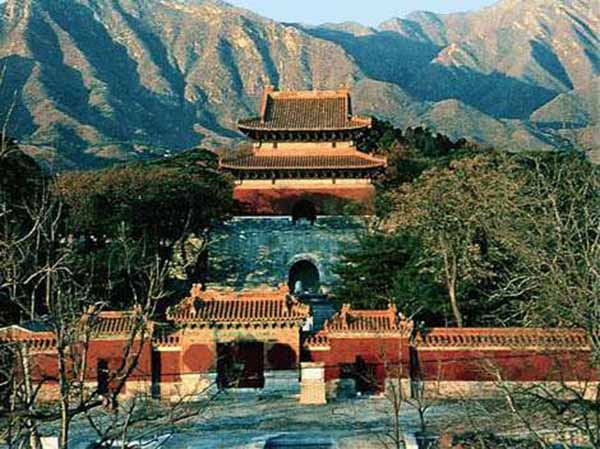

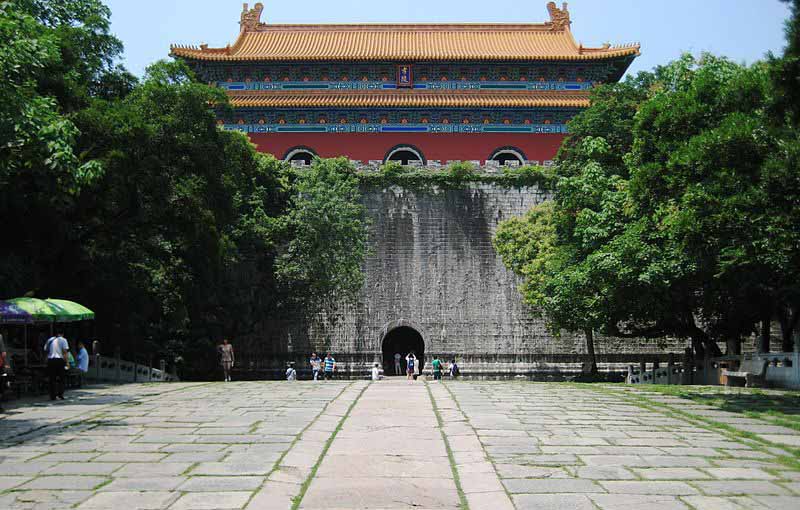
Ming Xiaoling Mausoleum is the tomb of the Hongwu Emperor, the founder of the Ming Dynasty. It lies at the southern foot of Purple Mountain, located east of the historical centre of Nanjing, China. Legend says that in order to prevent robbery of the tomb, 13 identical processions of funeral troops started from 13 city gates to obscure the real burying site. The construction of the mausoleum began during the Hongwu Emperor's life in 1381 and ended in 1405, during the reign of his son the Yongle Emperor, (see below) with a huge expenditure of resources involving 100,000 laborers. The original wall of the mausoleum was more than 22.5 kilometres long. The mausoleum was built under heavy guard of 5,000 troops.
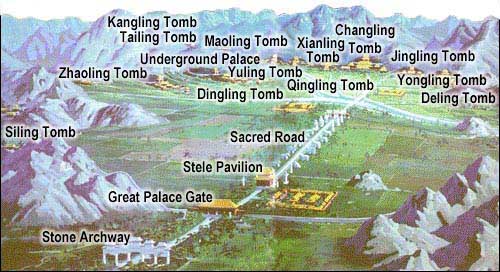
Panoramic View -- Click Arrows for Full Screen and Close-ups
The Thirteen Tombs of the Ming Dynasty is the resting place for 13 of the 16 Ming emperors. The Ming Tombs (Shisan Ling) are China's finest example of imperial tomb architecture. The site of the Ming Dynasty Imperial Tombs was carefully chosen according to Feng Shui (geomancy) principles. According to these, bad spirits and evil winds descending from the North must be deflected; therefore, an arc-shaped area at the foot of the Jundu Mountains north of Beijing was selected. This 40 square kilometer area - enclosed by the mountains in a pristine, quiet valley full of dark earth, tranquil water and other necessities would become the necropolis of the Ming Dynasty.
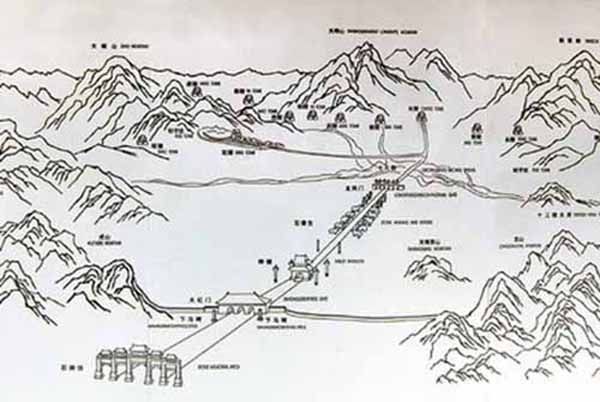
A seven kilometer road named the "Spirit Way" (Shendao) leads into the complex, lined with statues of guardian animals and officials, with a front gate consisting of a three-arches, painted red, and called the "Great Red Gate".
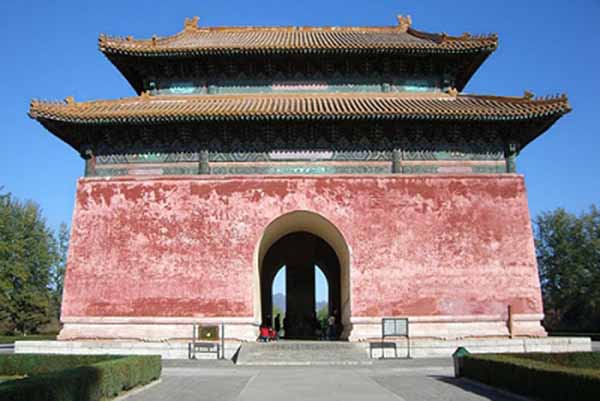
The Spirit Way, or Sacred Way, starts with a huge stone memorial archway lying at the front of the area. Constructed in 1540, during the Ming Dynasty, this archway is one of the biggest stone archways in China today.
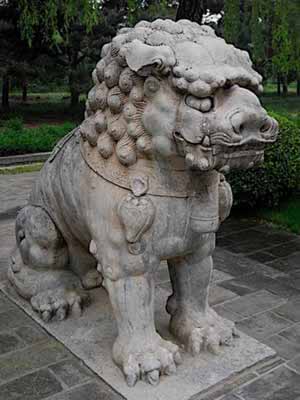
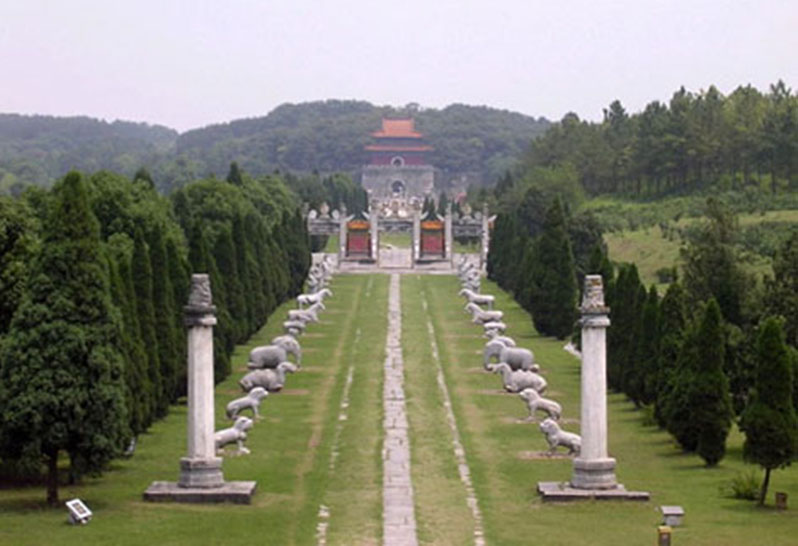
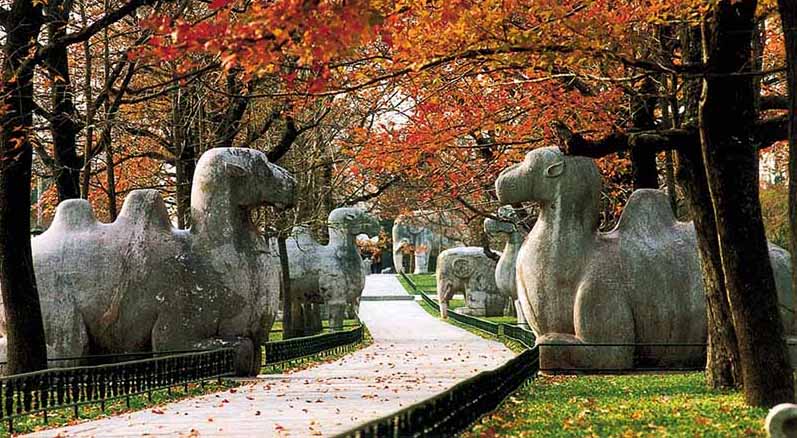
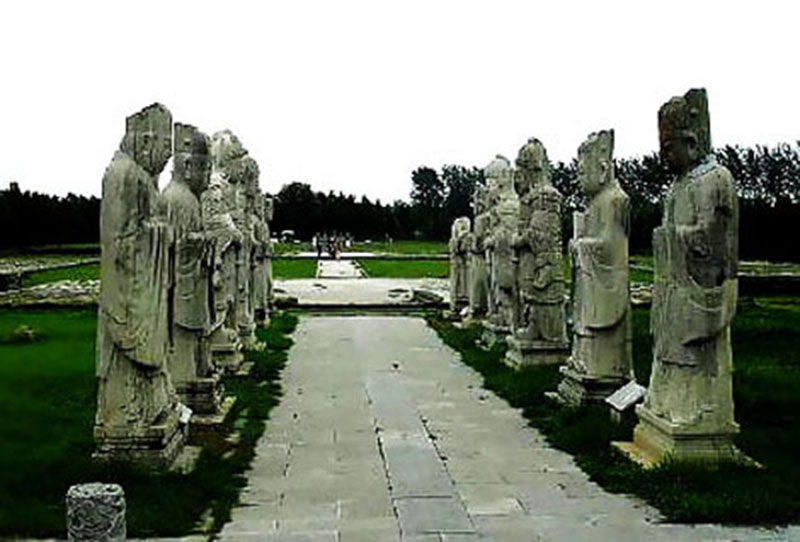
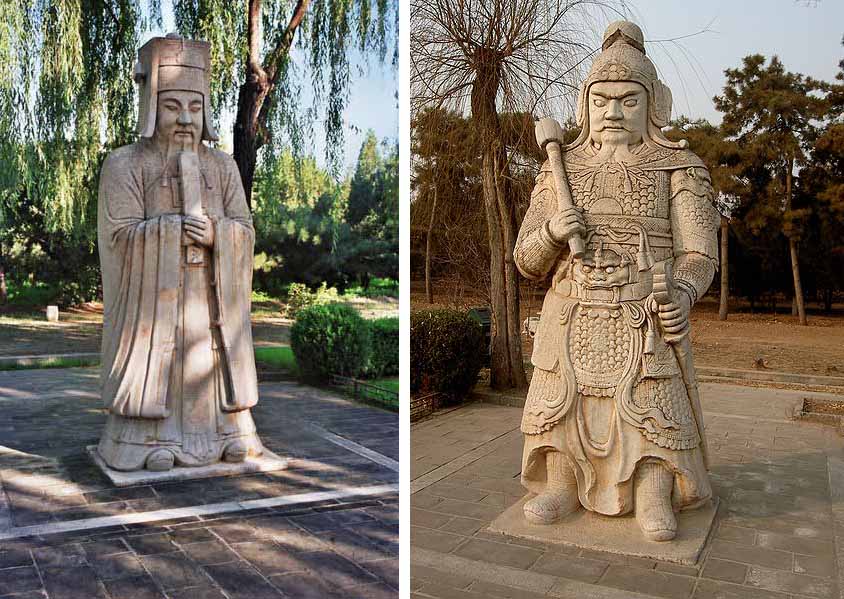
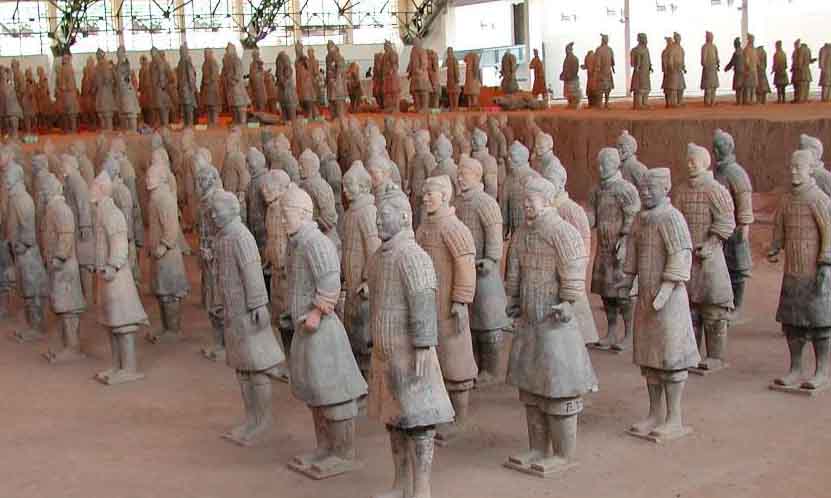
Sculptures of guardian figures, whether the Terracotta Army or later Buddhist deity figures, are common. Early burial customs show a strong belief in an afterlife, and a spirit path to it that needed facilitating. Funerals and memorials were also an opportunity to reaffirm important cultural values such as filial piety and "the honor and respect due to seniors, the duties incumbent on juniors".
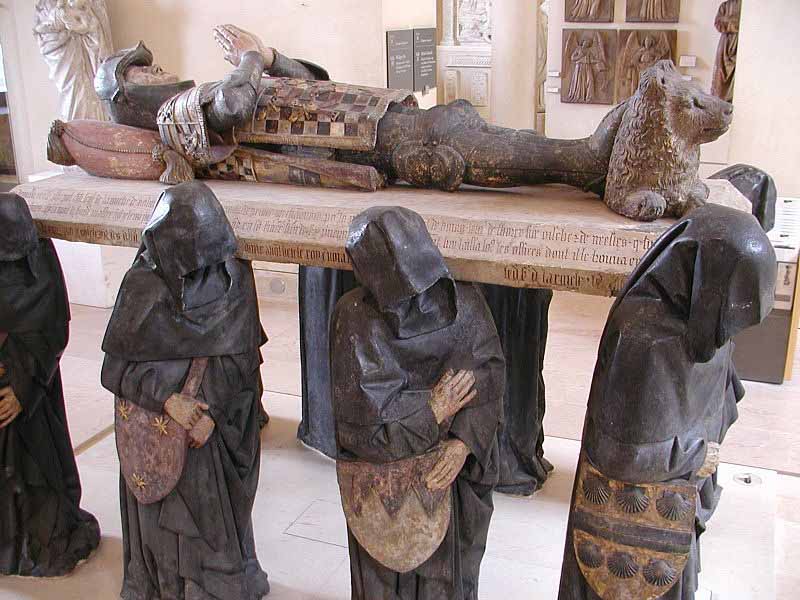
The common Chinese funerary symbol of a woman in the door may represent a basic male fantasy of an elysian afterlife with no restrictions. In all the doorways of the houses stand available women looking for newcomers to welcome into their chambers Han Dynasty inscriptions often describe the filial mourning for their subjects.
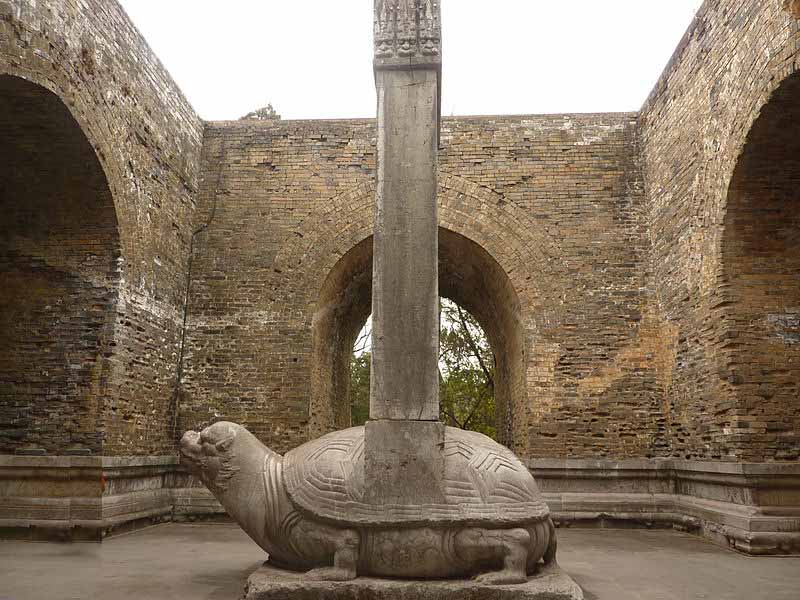
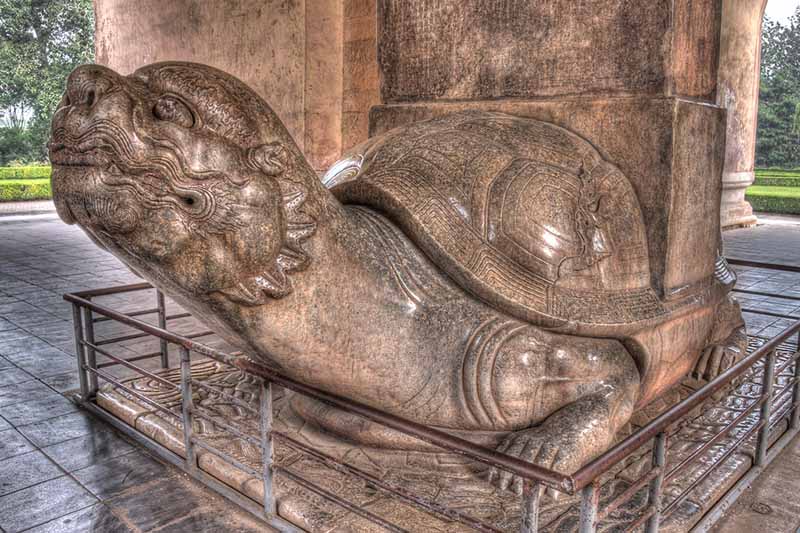
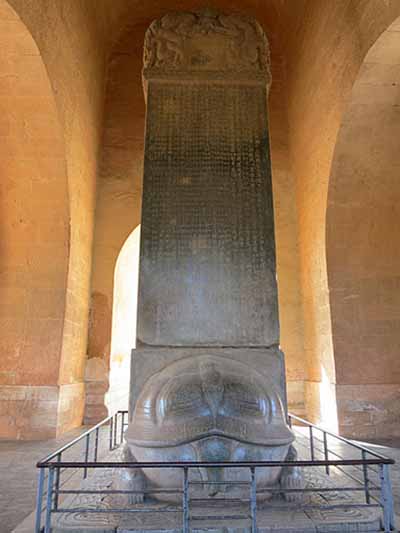
Farther in, the Shengong Shengde Stele Pavilion can be seen. Inside it, there is a 50-ton tortoise shaped dragon-beast carrying a stone tablet. This was added during Qing times and was not part of the original Ming layout. Four white marble Huabiao (pillars of glory) are positioned at each corner of the stele pavilion. At the top of each pillar is a mythical beast. Then come two Pillars on each side of the road, whose surfaces are carved with the cloud design, and tops are shaped like a rounded cylinder. They are of a traditional design and were originally beacons to guide the soul of the deceased, The road leads to 18 pairs of stone statues of mythical animals, which are all sculpted from whole stones and larger than life size, leading to a three-arched gate known as the Dragon and Phoenix Gate.
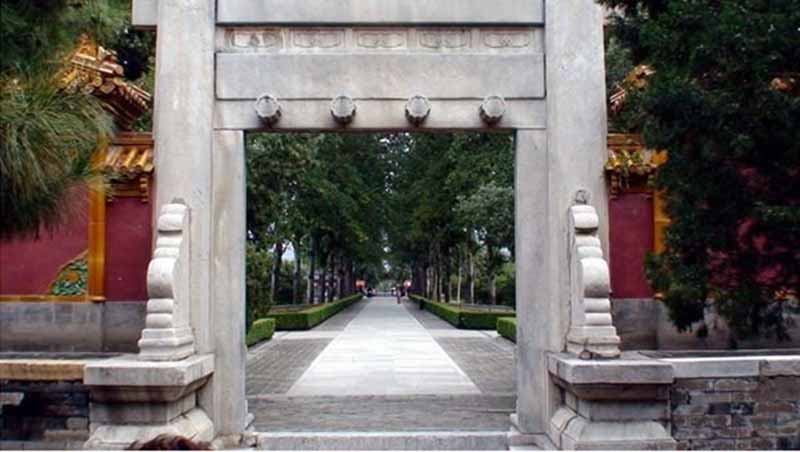
The Ming Tombs were listed as a UNESCO World Heritage Site in August 2003. They were listed along with other tombs under the "Imperial Tombs of the Ming and Qing Dynasties" designation. During the Ming dynasty the tombs were off limits to commoners, but in 1644 Li Zicheng's army ransacked and set many of the tombs on fire before advancing and capturing Beijing in April of that year. Presently, the Ming Dynasty Tombs are designated as one of the components of the World Heritage object, Imperial Tombs of the Ming and Qing Dynasties, which also includes a number of other sites in Beijing area and elsewhere in China.
The tombs are located 42 kilometers north-northwest of central Beijing, within the suburban Changping District of Beijing municipality. The site, located on the southern slope of Tianshou Mountain (originally Mount Huangtu), was chosen on the feng shui principles by the third Ming Dynasty emperor Yongle (born Zhu Di) (1402-1424), who moved the capital of China from Nanjing to its the present location in Beijing. The name Yongle means "Perpetual Happiness". He is credited with envisioning the layout of the Ming-era Beijing as well as a number of landmarks and monuments located therein.
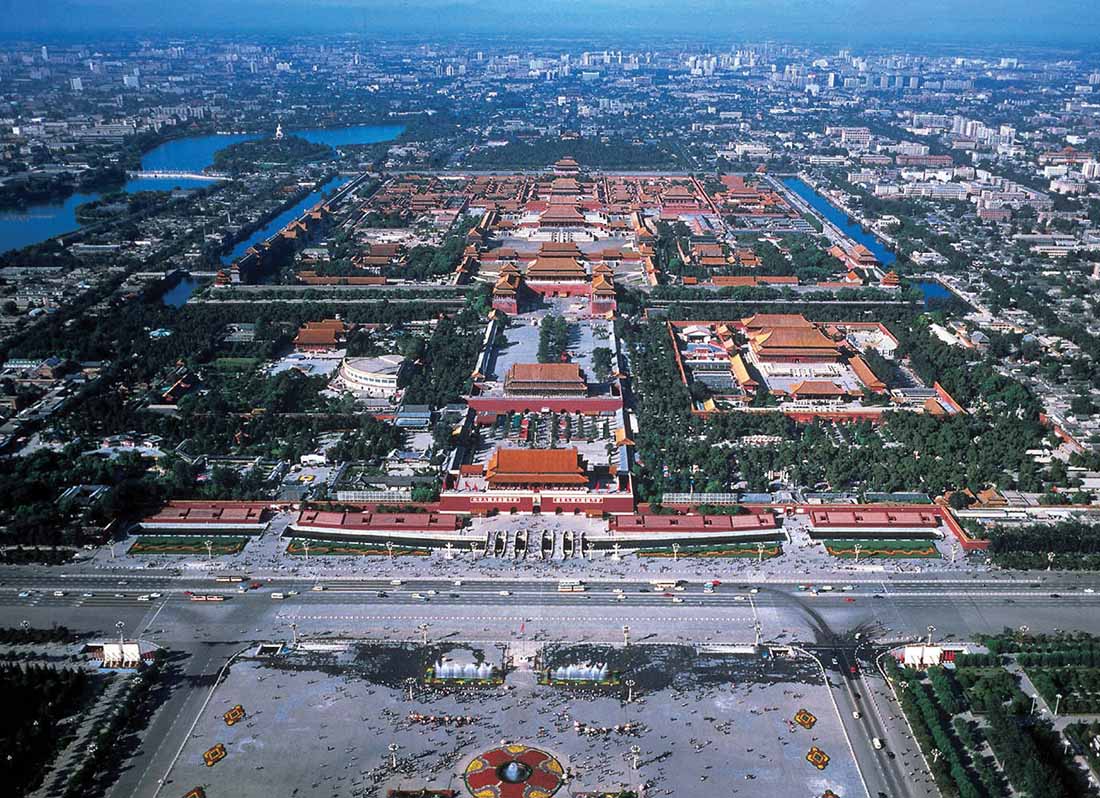
After the construction of the Imperial Palace (the Forbidden City) in 1420, the Yongle Emperor selected his burial site and created his own mausoleum. The imperial cemetery covers an area of 120 square kilometers with 13 Ming emperors, 23 empresses and a number of concubines, princes, and princesses buried there, and thus it is also called 13 Mausoleums. The Forbidden City was the Chinese imperial palace from the Ming Dynasty to the end of the Qing Dynasty. It is located in the centre of Beijing, China, and now houses the Palace Museum. For almost 500 years, it served as the home of emperors and their households, as well as the ceremonial and political center of Chinese government.
Built in 1406 to 1420, the complex consists of 980 buildings and covers 720,000 m2 (7,800,000 sq ft). The palace complex exemplifies traditional Chinese palatial architecture, and has influenced cultural and architectural developments in East Asia and elsewhere. The Forbidden City was declared a World Heritage Site in 1987, and is listed by UNESCO as the largest collection of preserved ancient wooden structures in the world.
Since 1925, the Forbidden City has been under the charge of the Palace Museum, whose extensive collection of artwork and artifacts were built upon the imperial collections of the Ming and Qing dynasties. Part of the museum's former collection is now located in the National Palace Museum in Taipei. Both museums descend from the same institution, but were split after the Chinese Civil War.
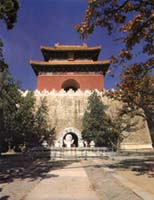
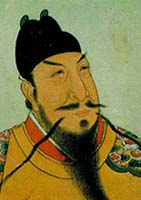
Changling is the tomb of Emperor Yongle and his empress. Built in 1413, the mausoleum extends over an area of 100,000 square metres. The soul tower, which tells people whose tomb it is, rests on a circular wall called the "city of treasures" which surrounds the burial mound. The "city of treasures" at Changling has a length of more than a kilometre.
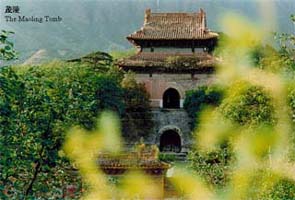
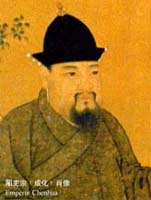
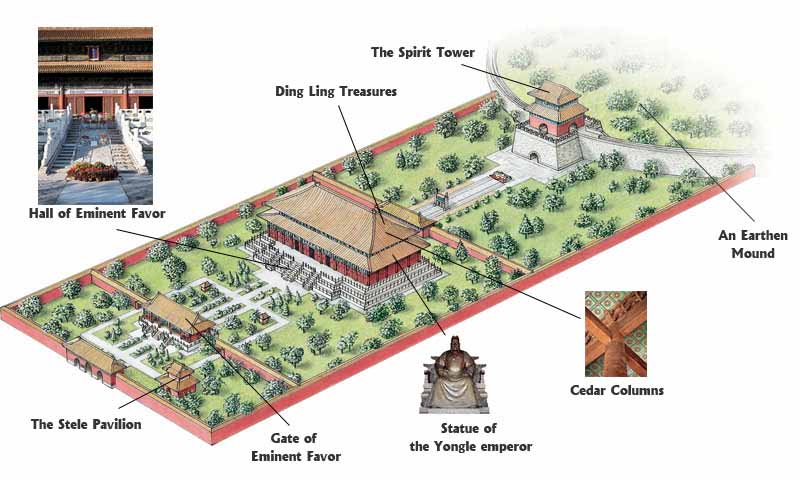
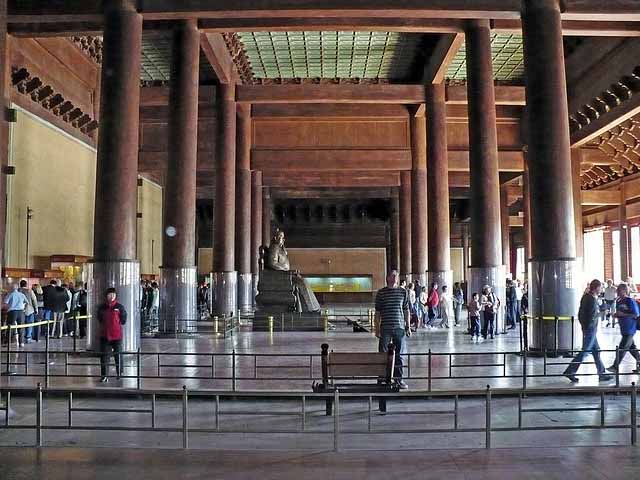
One of China's most impressive surviving Ming buildings, this double-eaved sacrificial hall
is erected on a three-tiered terrace. Cedar columns support the huge weight of the roof.
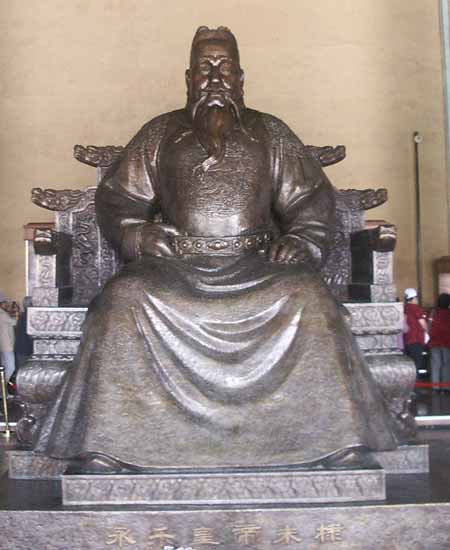
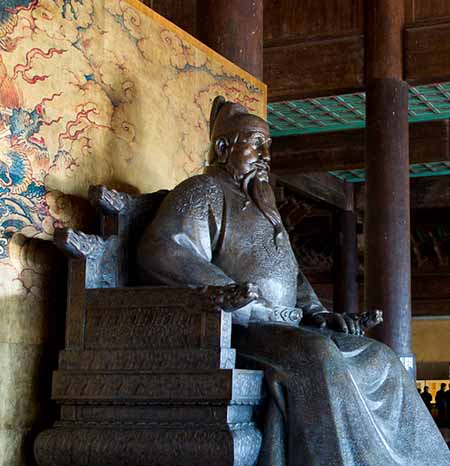
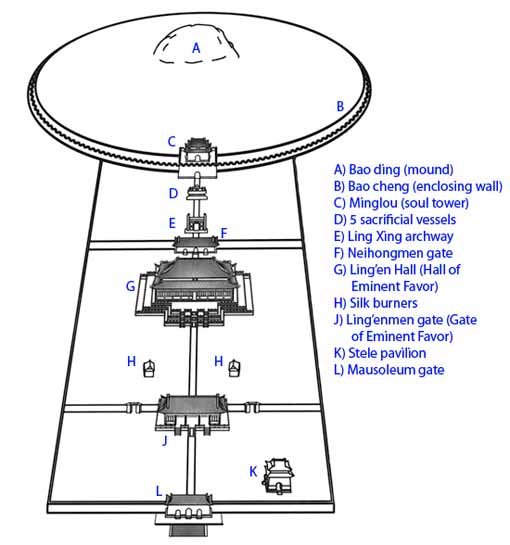

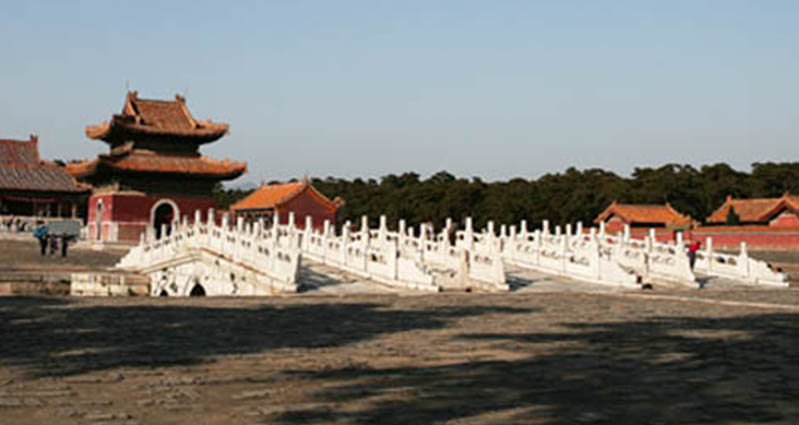
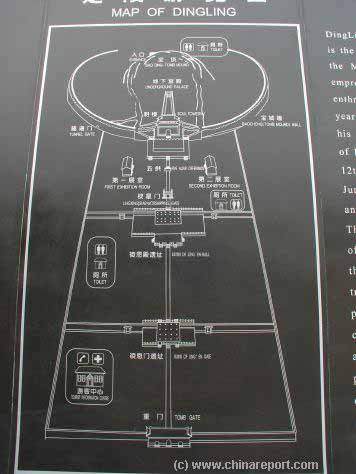
Dingling is under ground - about 27 meters deep. The main features are the Stone Bridge, Soul Tower, Baocheng and the Underground Place, which was unearthed between 1956 and 1958. The entire palace is made of stone. The Soul Tower is symbolic of the whole of Dingling and it forms the entrance to the underground chambers. The yellow glazed tiles; eaves, archway, rafters and columns are all sculptured from stone, and colorfully painted.

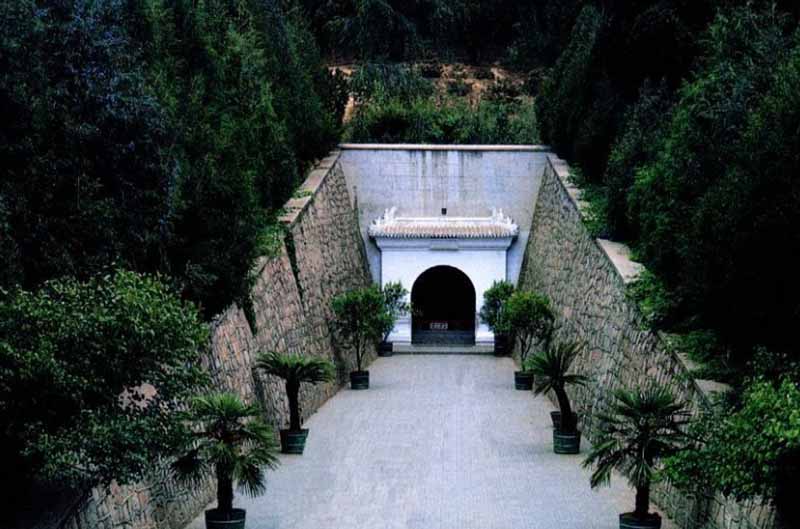
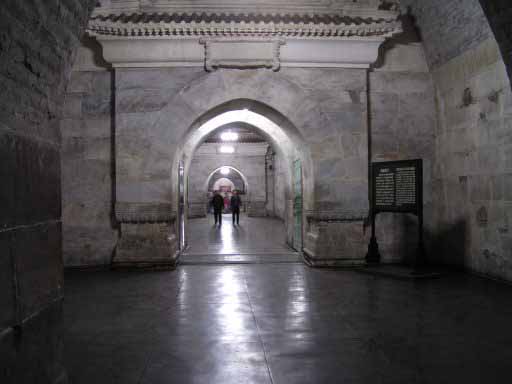
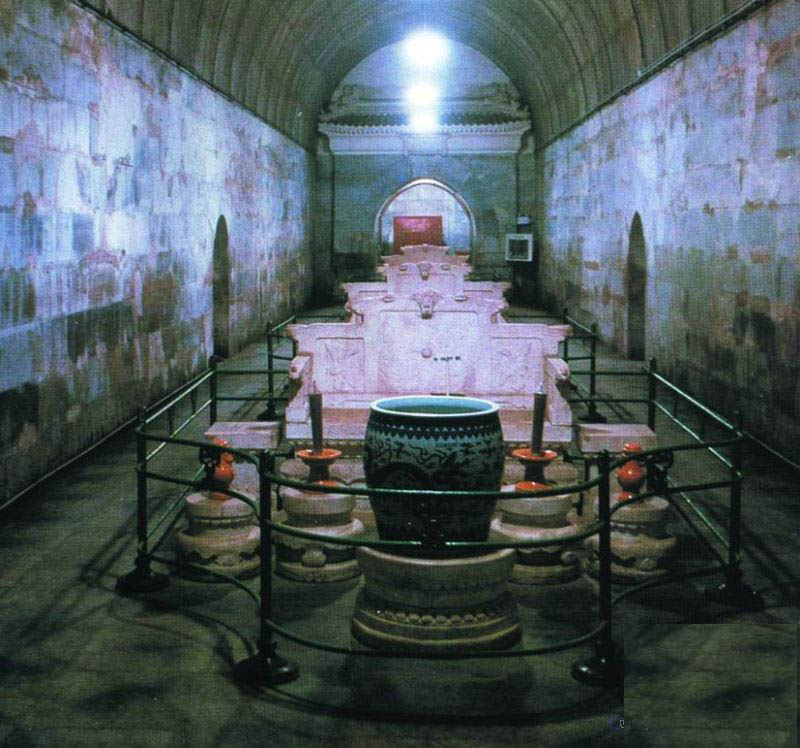
Here we find the tomb of the longest reigning Ming emperor, Wanli (1573-1620), is the only burial chamber of the 16 tombs to have been excavated and opened to the public. During the 1950s, archeologists were stunned to find the inner doors of the chamber still intact. Inside they found the treasures of an emperor whose profligate rule began the downfall of the Ming dynasty.
Dingling, literally means "Tomb of Stability". It is the only one of the Ming Dynasty Tombs to have been excavated. It also remains the only intact imperial tomb to have been excavated since the founding of the People's Republic of China, a situation that is almost a direct result of the fate that befell Dingling and its contents after the excavation.
The excavation of Dingling began in 1956, after a group of prominent scholars led by Guo Moruo and Wu Han began advocating the excavation of Changling, the tomb of the Yongle Emperor, the largest and oldest of the Ming Dynasty Tombs. Despite winning approval from premier Zhou Enlai, this plan was vetoed by archaeologists because of the importance and public profile of Changling. Instead, Dingling, the third largest of the Ming Tombs, was selected as a trial site in preparation for the excavation of Changling. Excavation completed in 1957, and a museum was established in 1959.
The excavation revealed an intact tomb, with thousands of items of silk, textiles, wood, and porcelain, and the skeletons of the Wanli Emperor and his two empresses. However, there was neither the technology nor the resources to adequately preserve the excavated artifacts. After several disastrous experiments, the large amount of silk and other textiles were simply piled into a storage room that leaked water and wind. As a result, most of the surviving artifacts today have severely deteriorated, and many replicas are instead displayed in the museum. Furthermore, the political impetus behind the excavation created pressure to quickly complete the excavation. The haste meant that documentation of the excavation was poor.
A more severe problem soon befell the project, when a series of political mass movements swept the country. This escalated into the Cultural Revolution in 1966. For the next ten years, all archaeological work was stopped. Wu Han, one of the key advocates of the project, became the first major target of the Cultural Revolution, and was denounced, and died in jail in 1969. Fervent Red Guards stormed the Dingling museum, and dragged the remains of the Wanli Emperor and empresses to the front of the tomb, where they were posthumously "denounced" and burned. Many other artifacts were also destroyed.
It was not until 1979, after the death of Mao Zedong and the end of the Cultural Revolution, that archaeological work recommenced in earnest and an excavation report was finally prepared by those archaeologists who had survived the turmoil.
The lessons learned from the Dingling excavation has led to a new policy of the People's Republic of China government not to excavate any historical site except for rescue purposes. In particular, no proposal to open an imperial tomb has been approved since Dingling, even when the entrance has been accidentally revealed, as was the case of the Qianling Mausoleum. The original plan, to use Dingling as a trial site for the excavation of Changling, was abandoned.
Only the Changling and Dingling tombs are open to the public. Changling, the chief of the Ming Tombs, is the largest in scale and is completely preserved. The total internal area of the main building is 1956 square meters. There are 32 huge posts, and the largest measures about 14 meters in height. It inhumes Emperor Zhudi, the fourth son of Emperor Zhu Yuanzhang. Travel China Guide recommends the Lingsi Palace in its second yard as really deserving a visit. This is unique as it is the only huge palace made of camphor wood. The ceiling is colorfully painted and supported by sixteen solid camphor posts. The floor was decorated with gold bricks.
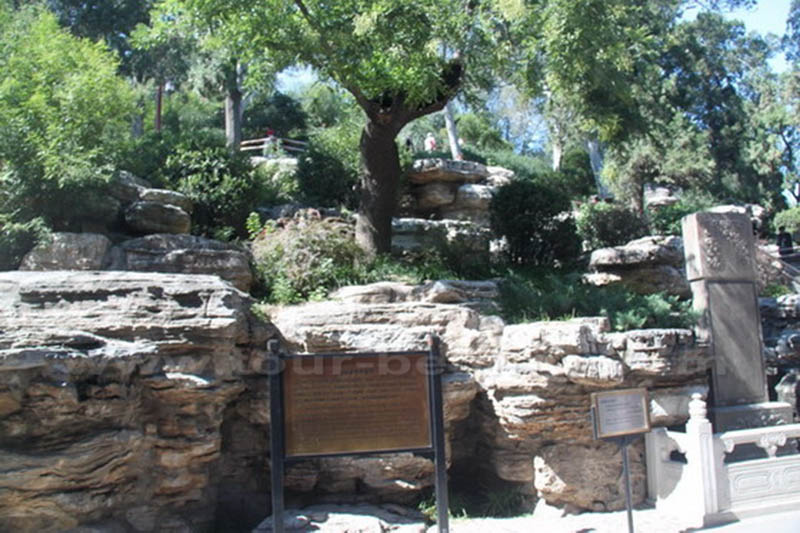
The last Ming emperor was buried at the location was Chongzhen, who committed suicide by hanging (on 25th of April 1644), was buried in his concubine Consort Tian's tomb, which was later declared as an imperial mausoleum Si Ling by the emperor of the short-lived Shun Dynasty Li Zicheng, with a much smaller scale compares to the other imperial mausoleums built for Ming Emperors.
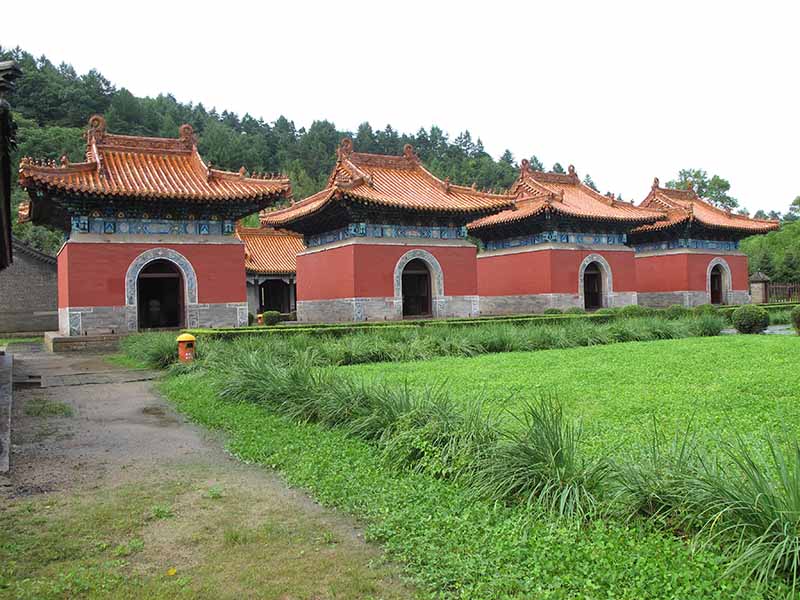
Yongling Tomb, built in 1536, is the tomb for Emperor Shizong, Zhu Houcong who ruled for 45 years as the
11th Ming Dynasty Emperor of China ruling from 1521 to 1567. His era name means "Admirable tranquility".
Funerary art varied greatly across Chinese history: tombs of early rulers rival the ancient Egyptians for complexity, and the value of the grave goods, and have been equally pillaged over the centuries by tomb robbers.
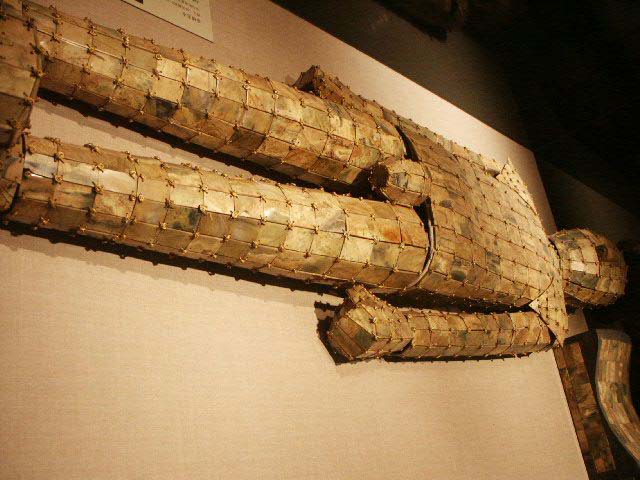
For a long time literary references to Jade burial suits were regarded by scholars as fanciful myths, but a number of examples were excavated in the 20th century, and it is now believed that they were relatively common among early rulers. Knowledge of pre-dynastic Chinese culture has been expanded by spectacular discoveries at Sanxingdui and other sites. Very large tumuli could be erected, and later mausoleums. Several special large shapes of Shang dynasty bronze ritual vessels may have been made for burial only.

The Tomb of Fu Hao is one of the few undisturbed royal tombs of the period to have been excavated.
Most funerary art has appeared on the art market without archaeological context.
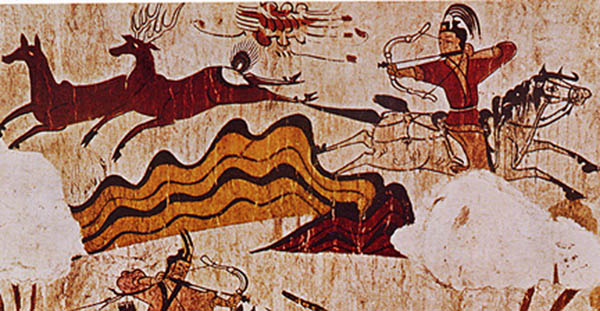
The Complex of Goguryeo Tombs are rich in paintings. In July 2004, they became the first UNESCO World Heritage site in the country. The site consists of 30 individual tombs from the later Goguryeo kingdom, one of Three Kingdoms of Korea, located in the cities of P'yongyang and Namp'o. Goguryeo was one of the strongest Korean kingdoms in the north east of China and the Korean Peninsula from 37 BCE to the 7th century CE. The kingdom was founded in the present day area of Northern Korea, and part of Manchuria around 37 BCE, and the capital was transferred to P'yongyang in 427 CE.
The murals are strongly colored and show daily life and Korean mythologies of the time. By 2005, 70 murals had been found, mostly in the Taedong river basin near Pyongyang, the Anak area in South Hwanghae province, and in Ji'an in China's Jilin province.
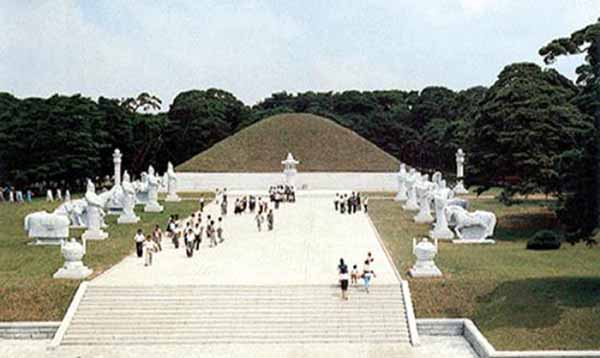
Google Images
1,000-Year-Old Tomb Reveals Murals, Stars & Poetry Live Science - November 11, 2014
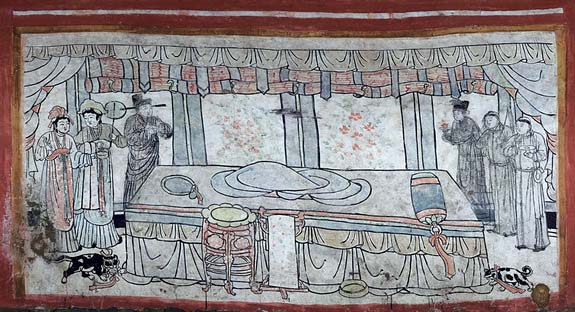
A 1,000-year-old tomb with a ceiling decorated with stars and constellations has been discovered in northern China. Found not far from a modern day railway station, the circular tomb has no human remains but instead has murals which show vivid scenes of life. "The tomb murals mainly depict the daily domestic life of the tomb occupant," and his travels with horses and camels, a team of researchers wrote in their report on the tomb recently published in the journal Chinese Cultural Relics. On the east wall, people who may have served as attendants to the tomb's occupant are shown holding fruit and drinks. There is also a reclining deer, a crane, bamboo trees, a crawling yellow turtle and a poem. The poem reads in part, "Time tells that bamboo can endure cold weather. Live as long as the spirits of the crane and turtle."
Ancient Tomb of Murals Discovered in China Live Science - June 17, 2013
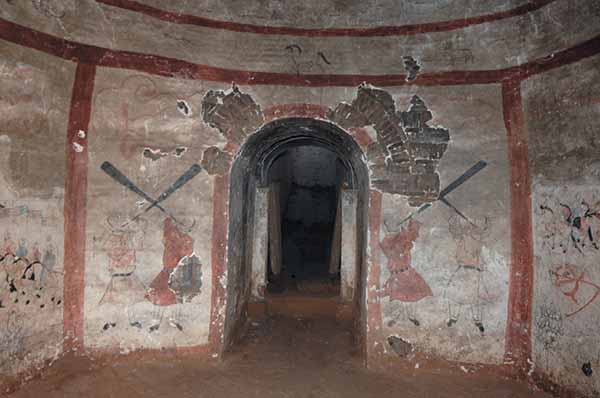
A colorful, well-preserved "mural tomb," where a military commander and his wife were likely buried nearly 1,500 years ago, has been uncovered in China. The domed tomb's murals, whose original colors are largely preserved, was discovered in Shuozhou City, about 200 miles (330 kilometers) southwest of Beijing. Researchers estimate that the murals cover an area of about 860 square feet (80 square meters), almost the same area as a modern-day bowling lane. Most of the grave's goods have been looted, and the bodies are gone, but the murals, drawn on plaster, are still there. In a passageway leading into the tomb, a door guard leans on his long sword watching warily. Across from him, also in the passageway, is a guard of honor, supported by men on horses, their red-and-blue uniforms still vivid despite the passing of so many centuries.
China finds ancient tomb of 'female prime minister' BBC - September 12, 2013
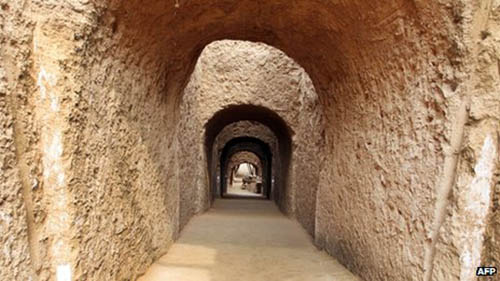
The ancient tomb of a female politician in China, described as the country's "female prime minister", has been discovered, Chinese media say. The tomb of Shangguan Wan'er, who lived from 664-710 AD, was recently found in Shaanxi province. Archaeologists confirmed the tomb was hers this week. She was a famous politician and poet who served empress Wu Zetian, China's first female ruler. However, the tomb was badly damaged, reports said. The grave was discovered near an airport in Xianyang, Shaanxi province, reports said. A badly damaged epitaph on the tomb helped archaeologists confirm that the tomb was Shangguan Wan'er's, state-run news agency Xinhua reported. Experts described the discovery as one of "major significance", even though it had been subject to "large-scale damage".